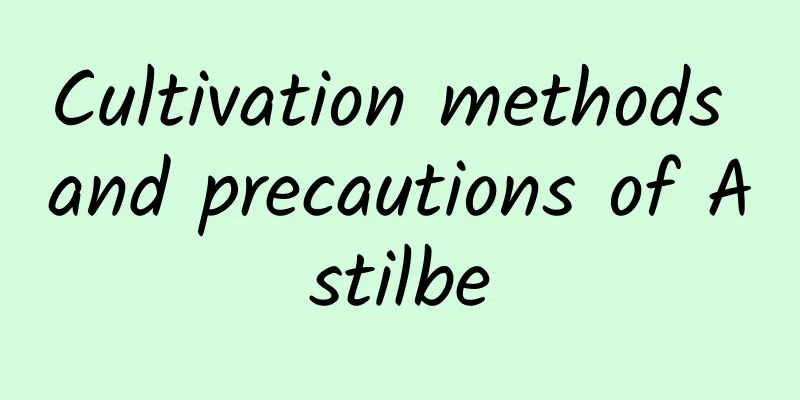Cultivation methods and precautions of Astilbe

|
Astilbe is a relatively easy plant to grow. It is a plant with tuberous rhizomes, so generally speaking, we can buy its rhizomes online and plant them ourselves. It is best to buy and plant them during the Spring Festival or autumn, when the survival rate is higher. The survival rate will be affected in summer. How to cultivate Astilbe1. Soil According to the growth habits of Astilbe, it is generally better to choose some loose, fertile, well-drained sandy soil as the growth medium. After selecting the soil, do not put it into use immediately. You should also be prepared to disinfect the soil to prevent diseases and pests in the soil from affecting the plants. 2. Lighting Astilbe is a plant that prefers sunlight but does not like being exposed to strong light, so it is necessary to manage the light when cultivating it. Generally speaking, in the summer when the sunlight is strong, appropriate shading should be done, and if it is in the winter when the light is weak, artificial lighting should be provided depending on the situation. 3. Temperature Astilbe is a plant that prefers high temperatures. Normally, temperatures between 15 and 35 degrees Celsius can meet their normal growth needs. Therefore, in winter, it is necessary to keep Astilbe warm, and the minimum growth temperature should not be lower than 3 to 5 degrees Celsius. Astilbe care precautions1. Pay attention to fertilization management The growth of Astilbe cannot lack nutrients, otherwise it will lead to slow growth of the plant or even death. Therefore, basic fertilizer should be applied first to increase the survival rate of seedlings. In the later stage of growth, appropriate top dressing should be applied. 2. Pay attention to watering management Astilbe itself prefers a humid growing environment, so after planting, it is necessary to water it thoroughly once to increase the survival rate. Next, you should pay attention to watering it frequently in the summer, because more water evaporates in the summer. In the winter, you can appropriately reduce the number of watering. |
<<: Cultivation methods and precautions of weeping jasmine
>>: How many days does buckwheat grow?
Recommend
The efficacy and function of white jasmine and how to eat it
1. Efficacy and Function The white jasmine flower...
The efficacy and function of pennyroyal
Purify the air We all know that it not only emits...
How to propagate jasmine
1. Seed propagation It can be propagated by sowin...
How to transplant old leek roots
Chives are native to China. They are rich in nutr...
What to do if the leaves of Desert Rose turn yellow
1. Change the breeding environment: Reason: Deser...
Can lotus seed shells be used as fertilizer?
Lotus seed shell fertilizer contains rich nutrien...
How to grow Moss Pink
1. Maintenance methods 1. Temperature: It can gro...
Methods and techniques of loofah planting
Luffa prefers moist, fertile, loose and well-drai...
How often should carnations be watered?
1. Watering during the seedling stage After repot...
How big a flower pot should I use for roses?
1. Flowerpot size When caring for roses, the size...
What is the average yield of Chinese cabbage per mu?
Chinese cabbage has a long history of cultivation...
How to propagate Daphne odora and what to pay attention to
How to propagate Daphne koreana There are four ma...
Cultivation and management methods of potted bergamot (how to maintain bergamot bonsai to make it bear fruit)
First, suitable soil: Buddha's hand is suitab...
Which season is better for planting succulents?
Nowadays, many people grow several pots of succul...
A comprehensive list of the common reasons why flowers die when grown at home!
asparagus Common causes of death: The air is dry ...









